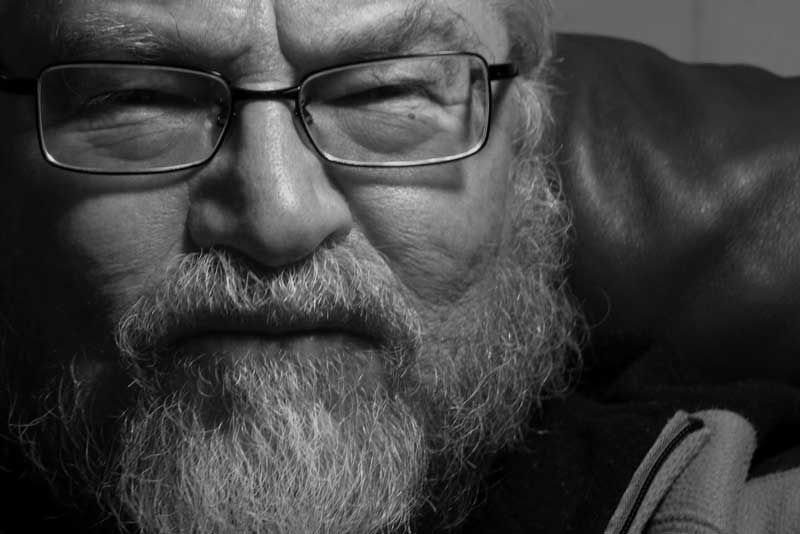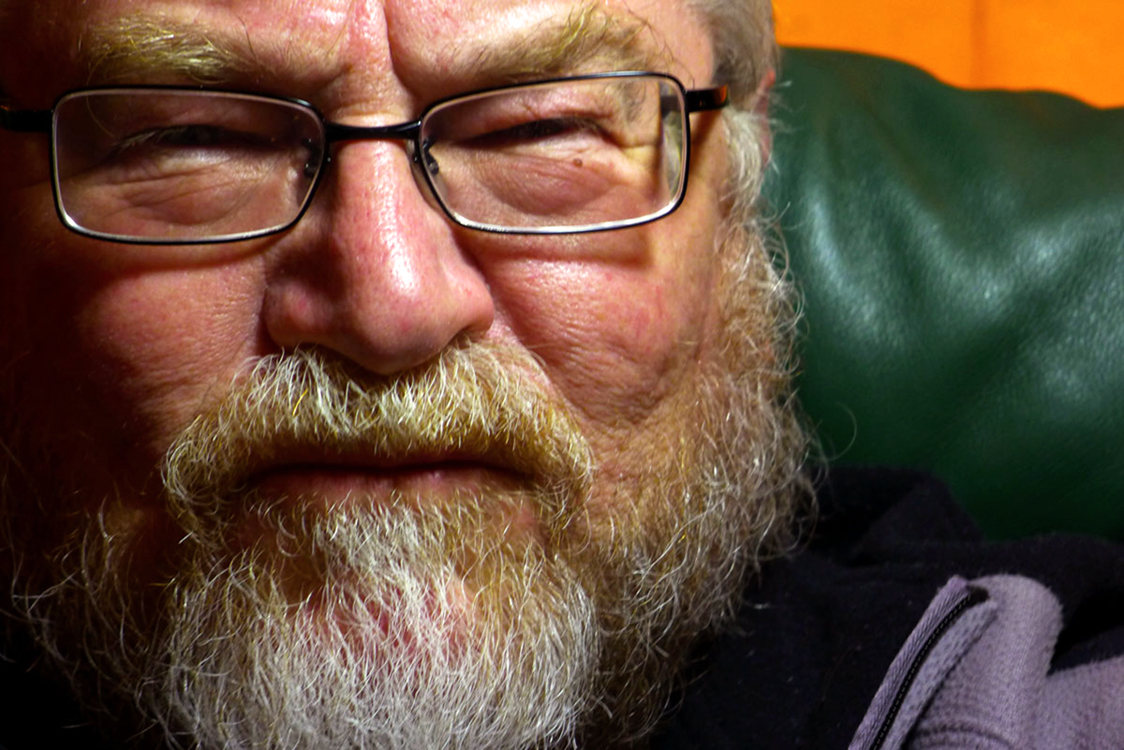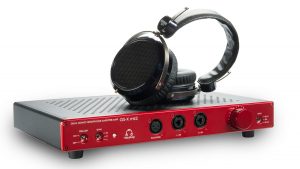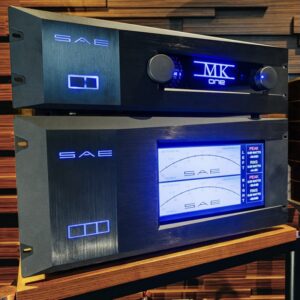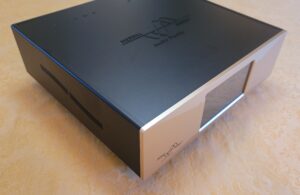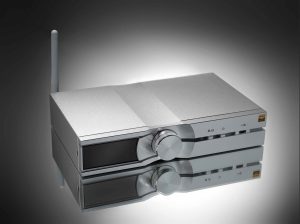What?
My first "hi fi" stereo box, in 1957, was an elegantly constructed Magnavox LP changer with a built-in amp-preamp feeding two inch mono speakers. All of this consumed a minimal internal and external footprint. The device sat on splayed legs to raise it to easy access. It made sound of some discernible sort resembling music. It was not musical itself, but suggested something akin to Miles Davis' 1949 nonet underwater or Ella Fitzgerald lost in a dense forest looking for Roy Eldridge.
Beggars don't choose, so the gift was a significant support to my burgeoning devotion to music in general, jazz and classical recordings in particular. When I went to Princeton in fall 1960, I bought an affordable tube-based integrated amp an upper class man hawked on campus, and bought cheap home-made speakers from another freshman in Holder Hall. Its glory was commandeered by interconnects affiliated with lamp wire's stunning resolution. One recalls how modest one's accommodation to sonic need dampened by poverty once was. Necessities of two kinds, almost self-negating, nurtured ferocious emotional hunger.
My good luck throughout those early years of immersion—Duke Ellington live at Newport, Pablo Casals solo renderings of Bach's cello suites, Jobim with Stan Getz, Toscanini's crazed readings of Beethoven symphonies—was the truly wonderful hand made all-tube stereo system that my pal, Bill Polhemus, had for our maniacal devotion to his brother's world-class jazz LP collection. Nothing was more fortunate for my aesthetic dementia than this fantastic recreation of music's tactile, emotional and divine palpability! We spent each Saturday, mid-afternoon until dawn for three continuous years, grooving on the greatest jazz beautifully recorded delivered with truly elite sonic reproduction.
No doubt that early deep encounter with musical rapture's spiritual intimacy warped my musical need and outlook forever on. I'm sure I cannot recall (as my friend and colleague Greg Weaver can) all the iterations of assembled sonic gear that have defined my last forty years. Several speakers across this span have earned my veneration. For thirty-one years my LINN turntable has remained a constant, augmented by various vinyl-boosting preamps. I laugh out loud, sitting alone, to recall the numbers and kinds of interconnects that have moved in and out. In the slender girth of a nutshell, I can tuck a note that explicates sonic systems, complete and whole, that I've lived with that earn my highest gratitude and critical appreciation. The one I now call THE CHEERFUL BEAST, which tugs at my heart each day, is the only one that I'd list in that note for my nutshell archive.
Acoustic Zen Crescendo speakers augmented by Magnepan panels, Kubala-Sosna Elation and Emotion cables throughout, Tascam digital delivery in several ways and several units (extraordinary in their sonic accuracy and musical honesty: nothing colored or exaggerated); and, at the exact heart of it all, Playback Designs state-of-the-art integrated analog amp and preamp bonded in a single chassis to their unrivaled DAC (generously redundant inputs and outputs): this crafts, with beguiling plangent precision, a wholly convincing and alluring musical soundstage that I can imagine enjoying until my time is done above ground.
Why?
My buddy Weaver, with infinite technical curiosity and well-delineated articulation, can dive deep into the inner sancta where impedance meets percussion, amperage delivers ostinato complexity. I'm a stranger in Dante's lower circles, a recording dorko and an example of listening's mesmerized witness replacing analytic doctorates. In truth, the two emphases are congenial if converged with tact and sonic love. My inclination here is, simply, to attest to the predominant ineradicable fact of the IPS-3's pedigree in action underway—delivering the REALITY of well-recorded music; recreating the ambient details and immediate propulsive force of individual instruments, drawing one's ears and heart and being to the musical event as if you are there... as close as one can be there without false emphases or clever dynamic attenuation.
Wherefore...
I'll put this bluntly. Playback Designs IPS-3, in the company of extraordinary speakers and state-of-the-art cables, promises sonic recreation of hair-raising subtlety and jaw-dropping intensity . . . and yet these nearly shocking enablements are not achieved by melodramatic sonic contours. Without demeaning speakers that err in that direction (Wilson's WAMM; alluring large MBLs, et al.) it's accurate to note the degree to which the high-end audio industry claims, by and large, to seek sonic truth yet, too often, succeeds in luring high priced customers to musical cartoons. One can also list amplifiers that stride in that direction. But the essential nature of truly great recorded music is always faithful to its venue, accurate in its tonal spectrum, convincingly holographic in its delicate coherence.

That is precisely what the Playback Designs unit accomplishes: musical force and fragility exposed before one's willing interest with the virtually unnameable complexity of dynamic tonal ecstasy that one's ear encounters in a superior hall, residing with benighted proximate placement.
I've recorded live jazz since 1965, recently for two nights in Paris. I've recorded clubs and halls, indoors and outdoors, in New York, Los Angeles, Boston, San Francisco, Sarasota, San Diego, Chicago, Tucson, Santa Barbara, Pittsburgh, Napa Valley, St. Louis, Orange County, Sausalito, Budapest, Venice, Honolulu, Salzberg, Athens, Rome, and Vienna. The air is different every place you record live. Each location has its own challenge, its virtues sometimes, always its obvious and also covert liabilities. Sound reinforcement for audience, for stage use, too, inevitably presents a challenge.
The mics you choose frequently determine success or failure, glory or disappointment. Check out, at your leisure, Les Koenig and Roy DuNann's recording of Ben Webster and Jimmy Rowles "live" at the Renaissance Club in L. A. (June 1960). Neumann, AKG and Telefunken mics were used sparingly but vividly to capture a fantastic set, featuring Jim Hall on guitar, one that makes you want to be there… and allows a large degree of that engaging illusion. Wilma Cozart Fine's astonishingly immersive live concert recordings, using only three mics, provide another example of recording's "holy grail." The lesson to be extracted here is that, sonically, less is more in the art of live recorded sound.
At the risk of taking off to launch unneeded praise, I'll note finally the elegant outcome of musical nirvana (or its close companion) created by a system now firmly at home for my instruction and delight is this: before the IPS-3 dropped majestically into my world, I lived the honest audio life of an over-educated dope. I strove to assemble musical vivacity and sonic truth without conflict or contradiction. Each near-approach to my litmus standard, LIVE MUSIC I'VE RECORDED, increasingly gained ground but still fell short.
When the IPS-3 arrived, as always hope poised against skeptical experience. It took little time for me to feel as if I'd climbed high promontories, finally (without strain), as if magic came to visit not long before Kareem Abdul-Jabbar dropped by to listen to his hero, and mine, Bobby Hutcherson. I love basketball at its zenith. So does Kareem. I love the inimitable jazz heritage. So does Kareem. Bobby Hutcherson became an example of the ineffable sublime ever since I first heard him at TSUBO's in Berkeley in 1967. Bobby's been a dear friend and musical hero no less for Kareem. Conversation during our time digging the great vibist's otherworldly enchantment was kept to focused comments on musical depth and intimacy. I hope Kareem felt Bobby's presence directly before our attentive calm.
If he did, that happened because this now transcendent system with the IPS-3 brought Bobby's delicate lyric splendor as a partner to our grasp.
Specifications
- Nominal Power: 130W (8Ω), 260W (4Ω) superimposed and linearized Class A/B
- Analog Inputs: 2 unbalanced (RCA), 1 balanced (XLR)
- Digital Inputs:
- AES/EBU for PCM up to 24bits/192kz and Single DSD
- Coax for PCM up to 24bits/192kHz and Single DSD
- USB for PCM up to 24bits/384kHz
- USB for DSD up to 11.2MHz (Quad DSD)
Playback Designs IPS-3
Retail: USD $13,000
Playback Designs
Alamo, CA 94507
USA
+1 925 820 4780
http://www.playbackdesigns.com
All photographs courtesy of Playback Designs; Jim Merod portrait courtesy of Jim Merod.








